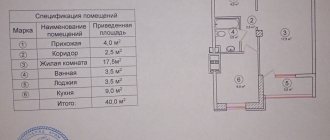Home » Division of property » Division of a residential building in kind between the owners
64
The procedure for dividing a residential building is much more complicated than dividing an apartment, since a certain part of the residential premises is considered indivisible property and cannot be divided. But often the relationship between several co-owners of a residential building becomes complicated for various reasons; they no longer want to live together, then they are faced with the acute question of the real division of the living space they own.
What is a real division of a house in kind
The real division of a residential building in kind is considered to be the termination by its co-owners of their rights to common property and its division into separate shares, each of which becomes the private property of one of the former co-owners.
In practice, such a division is quite difficult, especially if the co-owners are on hostile terms with each other and often simply cannot agree with each other.
But if the house remains in shared ownership, the co-owners often must make some joint decisions on the following issues:
- registration of new residents;
- repair;
- reconstruction of the house, its engineering networks,
and if the relationship is quite complex, this is extremely difficult or impossible, then most owners seek to modify their half into a separate living space.
This can be done by allocating a share of the house and the land under it, in other words, by actually dividing the real estate in kind.
In order to make such a division, home owners must resolve a number of issues:
- Determine the exact cost of a residential building, taking into account the cost of outbuildings. This can be done with the help of independent technical expertise.
- Based on the results of the examination, determine whether a natural division is possible while maintaining the equality of ideal shares.
An ideal share is a share of property that in reality cannot be seen or touched, since each of the co-owners owns not a real share of this house, for example, half a kitchen or a quarter of a living room, but a virtual share of property, implying a type of ownership of a particular house .
- Determine whether division in kind is possible in principle.
- Determine whether there is a need for additional work on equipment, for example, a separate entrance; if there is such a need, then determine their cost.
The procedure for dividing a house in kind
Before you start dividing a house in kind, you need to figure out whether it is technically possible to divide it. This requires a construction and technical examination, which will confirm or deny the possibility of a real division.
Such an examination will make it possible to determine whether and to what extent the residential building meets all technical requirements. Also, in the final conclusion, at the request of the co-owners of the house, the expert can include information about the real market value of the property, the options for refurbishment and redevelopment available for this property, and the cost of such refurbishment.
After the expert’s conclusion that real division of the house is possible, the owners must obtain permission to redevelop or rebuild it. Such permission is issued by local governments.
Next, the co-owners can use one of the possible options to divide the house:
- Allocation of shares.
- Division of jointly owned property.
Both the first and second division options are possible only if it is technically possible to divide the living space into separate, independent parts with a separate entrance for each of them.
Division of land under the house
When actually dividing a house, the question always arises about the actual division of the land plot underneath it.
Such a division is possible only if after it independent land plots are formed that did not change the permitted type of use during the division.
In addition to this condition, the main principle of the possibility of dividing a plot next to a house can be called the unity of fate of a separate part of the house with the land share that is adjacent to this part. In other words, the owner who receives a certain allocated share of a residential building will become the owner of the land plot on which his property is located.
Until the co-owners divide the house in kind, the allocation of a separate land plot is impossible, since all the land remains in the common shared ownership of all co-owners of the residential building.
Thus, in cases where, when dividing a residential building in kind, it is possible to arrange a separate entrance, it is also possible to divide in kind the land plot adjacent to the house. But on the condition that each part of the divided plot will not be less than the minimum norm of land allotment for the corresponding purpose. Otherwise, dividing the land is unacceptable and the plot is considered indivisible.
If, when dividing the house in kind, the land plot turns out to be indivisible among the co-owners of the house and land, they can actually divide the house, but without dividing the land, it will remain in their shared ownership.
What information must be provided?
The written permission of each owner of a housing property subject to reconstruction must contain the following information:
- Last name, first name, patronymic and address of the person giving permission.
- Document data confirming his ownership of the property.
- Consent to carry out repair work indicating the full name of the initiator.
- Confirmation of familiarization with the project for future work. All work must be listed in detail.
- Date of preparation of the document, signature of the applicant.
The application is drawn up in free form and submitted by all homeowners to local authorities.
In an apartment building
In apartment buildings, redevelopments that require permission from neighbors include:
- dismantling the entrance doors to the apartment and installing new ones.
- Changes to the facade of the building, reconstruction of the balcony.
- Increasing the area of the apartment due to the common ownership of all residents.
- Changing the location of window and door openings, etc.
A one-story, but two-apartment (or more) house is legally considered an apartment building and the owner of this house only owns partitions and interior decoration. All external communications and external walls are the common property of all owners of this residential building. And in this case, it turns out that by demolishing his half, the owner destroys the common property.
In private (blocked) housing construction
When building on your own separate plot, it is required to obtain the consent of neighbors if:
- Construction of a residential building or extension at a distance of less than 3 meters from a neighbor’s property.
- Construction of an outbuilding less than 4 meters from a neighbor’s property.
- Construction of non-residential premises (gazebos, canopies) at a distance of less than 1 meter from the neighboring plot.
- if the windows of the constructed house are located at a distance of less than 6 meters from the windows of the neighbor’s house.
- The distance between buildings on your and your neighbor's property is less than that required by fire safety rules (from 6 to 15 meters depending on the material of the buildings).
If any of the above-described construction work has already been carried out, but permission to carry it out has not been received, obtaining the consent of the neighbors is also necessary for official registration
changes.
Having a building permit from your neighbors will greatly simplify the process of legalizing the redevelopment of an apartment or a new building on your own site.
How to draw up a permit correctly?
Although the sample consent of neighbors to build a house and carry out other construction work is drawn up in free form, there are some uniform requirements that must be taken into account when drawing up the document.
- Permission must be in writing and cannot be considered granted only with the verbal consent of the neighbors.
- Permission must be granted by the owners , and not by tenants or residents of neighboring apartments (dacha plots).
- The document is drawn up like any other application from an individual, with a “header” indicating who is the author of the permit and to whom it is addressed.
- The document indicates the full name, passport details and home address of all neighbors and the initiator of construction.
- The permit must be signed by the owners of neighboring premises (areas).
- The authorization must be dated on the day it was drawn up or signed.
- It is also appropriate to indicate in the document what changes will be made as a result of construction. For example, ... I authorize the construction and registration of an extension size xxxx, floors xxxx, walls xxxx (blocks, wood, etc.).
- When constructing a private house, its location, cadastral number of the plot and some information about neighboring plots are indicated.
- When building on a private plot or legitimizing redevelopment, you can attach to the document a plan of the plot (apartment) in its current form and a project , which indicates and sketches what the plot (room) will be as a result of construction.
- apartment building
Permission from neighbors to redevelop an apartment can be obtained as a result of a positive decision at a general meeting of all homeowners (members of the housing cooperative) or after individual agreements with each apartment owner. It is allowed to draw up both a collective permit and separate individual consents of each owner.
The document is considered valid and has legal force if it is signed by all necessary neighbors and all mandatory conditions are met during its execution.
- Private house
Owners of their own plots need to obtain building permission only from those neighbors whose interests will be directly affected by construction.
To draw up and formalize the consent of neighbors in most cases, it only takes a few minutes of conversation with neighbors and following the instructions described above for drawing up the document.
Additionally, the document must be certified by a notary .
How many shares can a house be divided into?
The real division of the house can be carried out if there are no more than three co-owners, that is, in reality the house can be divided into no more than three parts.
If there are more than three co-owners, then the law allows for the separation of a share in kind from the common property.
When dividing home ownership, like any other joint property, there are certain conditions that such a division must meet:
- there should be no legal prohibitions on dividing a house;
- each part of a divided house must correspond to the purpose of the whole house;
- the totality of all parts of the house must correspond in value to the price of the whole house before its division;
- All parts must remain easy to use.
What to do if a neighbor does not give consent to construction?
If the neighbors do not give consent , and it is impossible to resolve this issue peacefully (either the “toad” is strangling them, or they are putting spokes in the wheels out of harm), go to court .
In this case, you should apply for permission to carry out construction from the architectural department of the executive committee in official written form, attaching all the necessary documents (copies). Accordingly, the refusal will also come in writing.
Then it (the refusal) must be appealed to a higher body of the executive committee or in court (here you will need the help of a professional lawyer).
sell the old one (with problematic neighbors) . Many settle on the second option, since even after a positive court decision, the reality of living with neighbors who are on the “war path” does not add optimism to homeowners.
Minimum dimensions of premises when dividing a residential building
In accordance with Russian legislation, the standard living space per person is 12 square meters. But in the case of a real division between the owners of a residential building, these rules do not apply.
In situations where any of the parties in the division receives an isolated room less than the established standard while fulfilling all other requirements (sanitary and technical), no one has the right to refuse the division, referring only to the fact that the room is less than the standard.
But splitting the house into tiny shares is also unacceptable. A living space of less than eight square meters is considered a dangerous limit for a person, therefore it is established that the minimum area of any individual share during division is a room measuring 8.1 square meters.
What to do if your house is under mortgage
Many questions are raised by the property on which the spouses pay the mortgage. Until the last mortgage payment is made, the house belongs by right to the lending institution. For this reason, spouses will need to obtain written consent from the bank to sell the house or change the payer.
There are the following number of options for how to deal with a mortgaged apartment:
- Sale. The funds received from the sale of the apartment will go towards repaying the mortgage. The remainder will be distributed between the spouses.
- Transfer of rights. In this case, the loan will be reissued for only one citizen. The other spouse will be paid monetary compensation.
- The mortgage will be paid by the spouses in accordance with the agreement and the apartment will belong to both parties.
Procedure and rules for dividing a private house into shares
Allocating a share in kind is nothing more than dividing a house into two separate rooms. The essence of this division is the transfer to each of the co-owners of an isolated premises with a separate entrance, suitable for living.
The main advantage of such a section is the ability of each owner to fully dispose of their part of the house:
- sell;
- give;
- leave as an inheritance;
- leave as collateral.
The actual division of a house in kind is possible subject to a number of conditions:
- each owner must have a separate entrance to his part of the house;
- each part of the allocated property must be suitable for permanent residence;
- all living quarters must be isolated;
- division of a land plot is mandatory, but only if after the division the individual plots do not change the type of permitted use, otherwise the land will remain in joint ownership.
Important. If the building is in disrepair or unsuitable for habitation, dividing the house in kind is impossible under any circumstances.
Before you start identifying a house in kind, you need to go through several stages of preparation:
- Obtain permission to redevelop the house and make changes to its technical plan. Since redevelopment always occurs when dividing a house in kind, fulfilling this point is mandatory.
- For each allocated share it is necessary to draw up a separate package of documents (cadastral and technical passport). Additionally, it is necessary to order land surveying.
- Next, the owners draw up a written agreement on the division.
- The next stage is a visit to Rosreestr. There, the documents will be examined, and if department employees do not find any contradictions with current legislation, then in two weeks all owners of their parts of the house will receive documents on ownership.
In what cases is neighbors' permission required for construction?
Permission from neighbors is required only for construction work that may directly affect residents of nearby houses (apartments).
This includes changes to the facade and load-bearing structures of an apartment (semi-detached) building, any redevelopment in a communal apartment, construction work in common areas, construction of a house or building at a distance too close to the neighboring plot.
The result of the construction work performed should not threaten their life, health, safety or contradict sanitary or fire safety standards .
Thus, at the legislative level, possible disputes and disagreements between neighbors are prevented and regulated (a neighbor who has given consent to construction can no longer challenge the illegality of the construction).
How to divide a house into two owners
There are often situations when they try to divide a two-flat house. When dividing such a house, an interesting situation arises - the property was originally intended for separate residence of two owners, each premises has a separate entrance, each premises has its own unique postal address, but Rosreestr refuses to register the property rights. The reason is trivial: the land under the house has a category intended for individual residential construction, and the house has the status of an apartment building.
In such situations, both owners of their halves of the house must first register the entire house as common shared ownership, thus confirming the intended use of the land. Then the division occurs according to the scenario described above: allocation of shares in kind.
Important. If such a house was built in 2006 or later, then before proceeding with the allocation of shares, it is necessary to obtain an act of putting the property into operation.
Legal side of the matter
Any real estate can belong to several owners at once. This is a legal fact. But when arranging separate entrances of one building, it is shared rather than joint ownership that is considered.
Otherwise the project will not be approved. Quite often, a house is divided between two owners by ex-spouses after a divorce. This is how they distribute property acquired during marriage. And this is the most common example when a property has 2 owners.
The Family Code of the Russian Federation provides that ex-husband and wife divide property strictly equally, unless, of course, they provide otherwise in a marriage contract or simply a personal agreement. That is, in the “classic” version, each of the former spouses gets exactly half of the house and, accordingly, half of the land plot under this house. At the same time, real estate objects do not end their existence; they still retain the same address and cadastral numbers.
Important: if a house has 2 owners (regardless of the reasons), each of them is issued a separate certificate of ownership of the house. And a separate certificate of ownership of the land under this house.
How much does it cost to divide a house into shares?
When dividing a house in kind, the owners will have to pay a certain amount of money, which varies in different situations.
For example, if the co-owners resolved the problem peacefully and agreed to enter into a voluntary agreement, then they will have to pay for the work of a notary to certify the agreement. The cost of such a service depends on the value of the property that the co-owners are going to divide.
So, if the cost of a house is up to 1 million rubles, the cost of the service will be two thousand rubles, plus 0.3% of the cost of the house.
If the property costs more than 1 million rubles, then the notary service will cost five thousand rubles, plus 0.2% of the price of housing construction.
When dividing a house through the court, the owner who files the claim will have to pay a state fee.
The cost of technical expertise ranges from 10 thousand rubles and above, depending on the complexity and volume of the expert report.
Government duty
When applying to the district court, a citizen undertakes to pay a state fee in accordance with the established norms of Russian legislation. Its size may vary based on certain factors.
The calculation procedure is presented in the following table:
| Cost of the statement of claim | Calculation |
| Up to 20,000 rubles | 4%, but not less than 400 rubles |
| From 20,001 to 100,000 rubles | 3% + 800 rubles |
| From 100,001 to 200,000 rubles | 2% + 1,300 rubles |
| from 200,001 to 1,000,000 rubles | 1% + 5,200 rubles |
| from 1,000,001 rubles | 0.5% + 13,200 rubles |
The state fee must be paid without fail. The value of the statement of claim is not the value of the entire object, but only that part for which the citizen claims.
Home division expert
Any real division of a house requires technical expertise. The expert conducting the premises inspection must answer the following questions:
- Is it technically possible to divide this house in kind?
- What are the possible division options in accordance with the shares of the owners of the house.
- What actions should be taken to redevelop the house.
- What is the approximate cost of the necessary redevelopment.
- The amount of monetary compensation that one owner will have to pay to another if it is not possible to divide the home ownership in proportion to the ideal shares.
- What is the market value of the house being divided in kind?
If the co-owners of a residential building decide to divide it in kind, it is advisable to contact a qualified lawyer, there are several reasons:
- Any real estate has a fairly high value; the risk of losing expensive property during illegal division is quite high.
- A lawyer will be able to competently protect the interests of the principal, tell you what documents will be required for dividing the house, what steps and in what sequence will need to be taken, and warn against illegal actions.
If you use the help of a lawyer to divide a house in kind, the entire division procedure will take place in a shorter time, and its result will be more favorable for the owner.
FREE CONSULTATIONS are available for you! If you want to solve exactly your problem, then
:
- describe your situation to a lawyer in an online chat;
- write a question in the form below;
- call Moscow and Moscow region
- call St. Petersburg and region
Save or share the link on social networks
(
3 ratings, average: 3.00 out of 5)
- FREE for a lawyer!
Write your question, our lawyer will prepare an answer for FREE and call you back in 5 minutes.
By submitting data you agree to the Consent to PD processing, PD Processing Policy and User Agreement
Useful information on the topic
21
How is a house bought with maternity capital divided during a divorce?
The most common and effective government assistance is for families with two and...
49
How to divide an apartment purchased with maternity capital during a divorce
In the usual case, in the absence of children, in the event of a divorce, everything...
7
How to divide a car during a divorce if it is on credit
During the divorce process, many families are faced with the division of property, in...
10
Division of an apartment under a military mortgage during a divorce
Any family can get divorced, including the family of a military personnel...
Division of real estate in case of divorce between spouses
During a marital relationship, often the most important and expensive…
23
How much does it cost to register a will with a notary?
A will is a one-sided document certified by a notary. It allows...
Is it possible to divide a house through court?
If it is not possible to resolve the issue peacefully, citizens can file a corresponding claim with a judicial authority. The application for division of the house is considered by the district court.
When the statement of claim is submitted to the authorized body, you will need to pay a state fee. You will also need to have the property assessed in advance.
The statement of claim must necessarily contain the following information:
- The name of the judicial authority to which the application is submitted.
- District court address.
- Personal information about spouses.
- Cost of the claim.
- Date of marriage certificate.
- Description of the property.
- Conditions for purchasing real estate.
- Request for division of the house.
- List of documents that is attached to the statement of claim.
- Date of the application.
- Personal signature.
What documents will need to be attached to the statement of claim:
- Copy of civil passport.
- A copy of the marriage/divorce certificate.
- Purchase/sale agreement, copy of the agreement with the bank (provided that the property was purchased on the basis of a mortgage) or other document confirming ownership.
- Extract from the Unified State Register of Real Estate.
- A copy of the completed home appraisal.
- A copy of the birth certificate of minor children. In the presence of.
- A receipt confirming payment of the state fee.
- Additional documents.
All copies of documents submitted to the authorized body must meet certain requirements. All information in them must be readable and understandable. Otherwise, the person will be refused to accept the documents.
When the court makes its decision, the parties will have one month to appeal it. After the expiration of this period, the court decision will enter into legal force.
Payment of compensation
It is practically impossible to divide a house fairly between spouses. For this reason, Russian legislation provides for monetary compensation.
What a citizen who is applying for appropriate compensation must take into account:
- The person who received the majority of the property must pay the other person appropriate monetary compensation.
- If there is a cooperative property, compensation must be paid based on the size of the shares.
- Housing is completely transferred to one person, who must provide compensation to another in the amount of his share.
Compensation can be paid not only in monetary terms. So, it can be provided as a car.
The amount can be established both by the parties to the case and directly by the judicial authority. It is calculated based on market value. For this purpose, an appropriate examination will be assigned.
Method No. 1. Peaceful agreement
The best option to divide the house would be a peaceful agreement between the owners. In this case, the home ownership does not lose its status as an integral piece of real estate, it simply becomes shared ownership.
From a technical and legal point of view, this is the easiest way to remodel a house for two owners. In this case, the division of the house occurs on the basis of an oral agreement or written agreement between the owners. It is better to choose the second option and have the drafted agreement certified by a notary office. This will help avoid property disputes in the future.
Before dividing your home, include the following in your agreement:
- current costs of maintaining the house;
- Payment of utility services;
- procedure for operating common areas (kitchen, bath, toilet, corridor).
When concluding a peace agreement, do not forget about dividing the land. Although if you plan to live together in the future, then this item is optional.
If there are difficulties in determining the share of each owner, then the problem can be resolved through the court. However, this is not the best option. The judge will not take into account the interests of the owners, but will simply suggest a compromise solution that will suit each of the parties.
If a compromise is not reached, the legal battle could drag on indefinitely. In this case, allocating a share in kind is suitable. We'll look at this option a little later.
Even in case of agreement, the house must be divided into two separate living spaces. In some cases, this will require redevelopment of the building. Construction work must be legalized and an expert report must be obtained that the changes made to the design will not lead to the destruction of the house.










